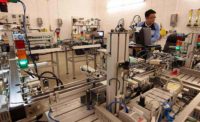Being green and sustainable is trendy in all industries today. Unfortunately, many different definitions and concepts exist, which can be confusing to small- and medium-sized companies.
Engineers at Oregon State University have addressed that issue by developing a new approach to sustainable manufacturing that encompasses a variety of economic, environmental and social impacts. Their strategy builds on previous approaches that considered various facets of sustainability in a more individual manner.
“Past methods often worked backward from a finished product and rarely incorporated the complexity of human social concerns,” claims Karl Haapala, an assistant professor of industrial and manufacturing engineering who runs OSU’s Industrial Sustainability Laboratory. The facility investigates everything from manufacturing processes to supply chain issues.
“Sustainable manufacturing is more about understanding and assessing tradeoffs, rather than win-win or win-lose,” adds Haapala. “Manufacturers must understand the impacts of their decisions—in terms of social and environmental impact, but also in terms of impact to the bottom line.
“All initiatives require investment,” warns Haapala. “Some of these will pay back quickly, and some will require continuous investment.”
According to Haapala, sustainable manufacturing is neither a win-win nor a win-lose proposition. “Companies must [consider] ‘At what cost can sustainable manufacturing be achieved?,’” he explains. “Similar to lean manufacturing, sustainable manufacturing is a journey.”
The Industrial Sustainability Laboratory defines sustainable manufacturing as “the set of systems and activities for the creation and provision of manufactured products that balance benefits for ecological systems, social systems and economic systems.”
Haapala has been studying sustainable manufacturing for more than a decade. “[When I was in graduate school], I realized that design and manufacturing decision making are inherently linked—that they control each other,” he points out. “Thus, broader impact can be made by understanding this linkage and finding ways to exploit it to positively [affect] society.
“My approach to sustainable manufacturing is not inherently new,” says Haapala. “My ideas are simply extensions of continuous improvement principles that engineers have strived to achieve for more than 100 years. It is about creating a safe workplace, using materials and energy efficiently, minimizing waste and finding innovative solutions to problems.
“Considering all of these issues holistically requires new methods and tools to assist the engineering decision making process,” adds Haapala. “Awareness is emerging that all of these decisions have interconnected consequences, and these must be understood. This is what drives my approach to sustainable manufacturing.”
Haapala and his colleagues have been applying these concepts at local companies, including Benchmade Knife Co. and Sheldon Manufacturing Inc., which produces laboratory equipment, such as anaerobic chambers, incubators and ovens.
They also participate in the OSU Industrial Assessment Center (IAC). Funded by the U.S. Department of Energy, the organization serves small- to medium-sized manufacturers in the Pacific Northwest. The center offers no-cost energy and productivity assessments.
Engineers tackle issues such as reducing energy use of various industrial systems, including boilers, compressed air and lighting. They also develop unique solutions for specific manufacturers.
Companies served include food and beverage processors, lumber and wood products manufacturers, and metal products manufacturers.
The IAC conducts a full-day assessment of the facility and systems.



